Cézanne
Yuko Otomo
January 2018
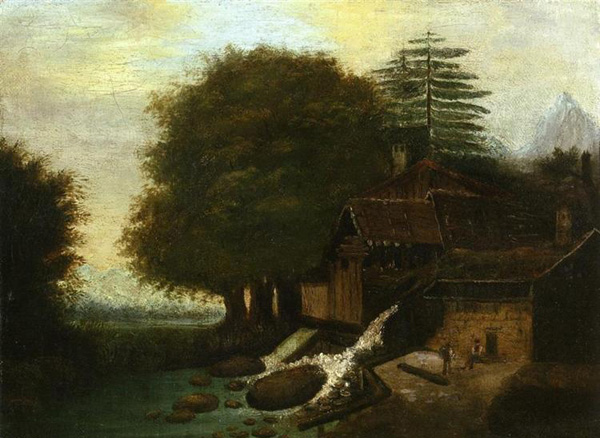 Landscape with Mill, Paul Cézanne, 1860, wikiart
Landscape with Mill, Paul Cézanne, 1860, wikiart
Cézanne: Mistral of Aix-en-Provence, Part One
Why is it that you do not say a word about Cézanne whom all of us recognize as one of the most astounding and curious temperaments of our time and who has a very great influence on modern art?
– Pissarro
He was my one and only master… Cézanne! It was the same with all of us… he was like our father.
– Picasso
I owned this canvas (*Cézanne’s Baigneuses) for thirty-seven years and I know it fairly well, I hope, though not entirely; it has sustained me spiritually in the critical moments of my career as an artist; I have drawn from it my faith and my perseverance…
– Matisse
From the amount Cézanne gives me to do now, I notice how very different I have grown.
– Rilke
色即是空空即是色
(color is void; void is color)
即心是仏
(heart/mind/soul/spirit itself is Buddha)
心とは,山河大地なり,日月星辰なり。
(heart/mind/soul/spirit is mountain/river/earth; it is sun/moon/stars.)
I don’t know why, but these Buddhist ideas came to my mind as I gather my thoughts on Cézanne in Aix-en-Provence. The first 色即是空空即是色 is from 般若心経 (Hannya-Shingyo: The Heart Sutra), one of the principle ideas of Mahayana Buddhism. The second & the third are words from 正法眼蔵 (Shobogenzo: Treasury of the Eye of the True Dharma) by 道元 (Dogen: early to mid 13th century Buddhist monk) who pioneered Zen in Japan. My basic translation is simple. The most difficult word is 心 (Kokoro). It is a word derived from a pictograph of a heart & it literally means “heart”, but in Japanese consciousness, it is more than that. It also contains “mind”, “soul” & “spirit” along with “heart” in one. So, I translated it as “heart/mind/soul/spirit.”
Why Buddhism when I talk of Cézanne? It is not a mystery. It is quite simple. What he was searching & trying to do is to “realize” these above “truths” in materials through his métier with the right formulas physically by “seeing.” I’ve always loved & respected Cézanne & his work for many reasons since I was young. When asked, “who is the most important artist for you if you have to choose one?” I answered “Cézanne” without failing.
I usually try not to write too personally when I write on art or artists. I try my best to be subjective but not personal in writing since I do not believe there is such thing as objective writing. Every writing is subjective no matter what. But being personal in the writing is another thing. I try to avoid revealing personal & private episodes relating to the subjects I write on as much as possible unless it is necessary. But, this time, writing on Cézanne, I let myself totally be personal since my relationship with him is extremely personal to begin with & only through “personal” & “physical” encounters with his “country”: Aix-en-Provence, I’ve finally solved most of the “unsolved” mysteries relating to him & his art.
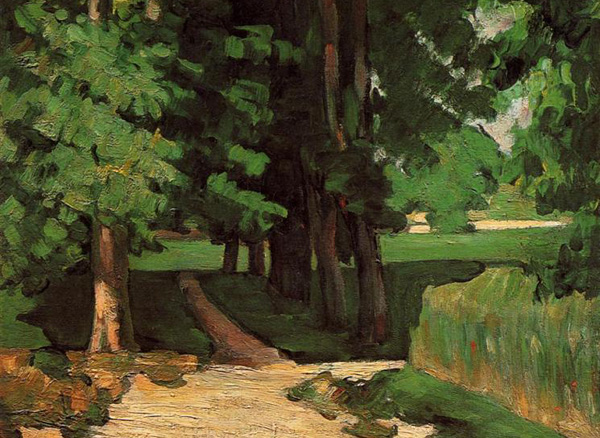 Lane of Chestnut Trees at Jas de Bouffan, Paul Cézanne, 1871, wikiart
Lane of Chestnut Trees at Jas de Bouffan, Paul Cézanne, 1871, wikiart
1. A Day Trip to Aix-en-Provence
Last fall, I had an amazingly blessed experience. Steve (Dalachinsky) & I were Marseille, being part of “De New York à Marseille ‘Just Listen!’ Festival” organized by our friend Aida Belhamd who used to live in NYC and was an intern for Arts for Art; the Vision Festival for sometime. Marseille is definitely one of my favorite cities in France. It’s the city where Antonin Artaud was born & Arthur Rimbaud died. The Fanny Trilogy & other charming & poignant stories of Marcel Pagnol took place in Vieux Port: the old port that was the gate way to Africa & the other parts of the world then. The city has a very special vibrant spirit because of its unique history & the mixture of races & cultures. It is an ancient Roman city & the climate there is superbly joyful & beautiful with plenty of sunlight & warmth.
We were there once almost 10 years ago. So, this is our second visit. While we were there, a 30 day garbage strike was still goinging on, but the people seemed to live with it, without being battered by it. During the week long festival, we interacted with Sabir Mateen, our beloved long time friend musician who now lives in Bologna, Italy & local musicians, a dancer & artists from the area such as Simon Sieger, Thomas Weirich, Maxine Briard, Vincent Laju, Pom Bouvier, Stephanie Auberville, Benoit Guillaume & more.
Steve & I always enjoy visiting artists’ houses & studios where they live & work, since doing so always gives us a direct connection to their lives & creation bypassing the time gap. The Gustave Moreau museum; the Rodin Museum; the Delacroix Museum in Paris are our favorite places to visit again & again when we are in the city. My biggest personal dreams have been to visit Monet’s house & garden/lily pond in Giverny; Auvers-sur-oise: the last place Vincent Van Gogh lived & died & Cézanne’s atelier in Aix-en-Provence. The first two dreams have been fulfilled fortunately to my joy in the last 10 years. The last dream to visit Cézanne’s live/work space happened to come true on October 15, Sunday, finally because of the thoughtful generosity of Aida & her friend Emmanuelle Taurines. Aix is not too far from Marseille; it is less than an hour trip by car. They arranged a day trip there for us before the evening event of the festival took place in the center of Aix. They invited their local artist friend, Kamel Khelif (*I’ll write about him in my “A Playroom of My Own” writing later), originally from Algeria, to join us.
Emmanuelle drove as Kamel & Steve talked & discussed art passionately, philosophically & metaphysically in depth as we moved deeper & deeper into Aix-en-Provence from Marseille. Kamel does not speak English & Steve does not speak French. So, Emmanuelle translated their conversation back & forth as she drove on the highway to Aix & Steve kept writing a poem as he talked with Kamel. It was a mesmerizing & exciting drive. Sometimes Kamel & Steve went into such depth about art & the art of painting. I was just too moved with the idea that we were heading to Cezanne’s atelier to join into their heated conversation. I was mute with the joy & just kept taking snapshots of the landscape as we passed through the magical dry & bright landscape of Provence, clearly knowing that photos would never capture the spirit of the place. But, I just couldn’t help it.
I saw pines after pines of different kinds, red soil, white rocks & the crisp blue sky through the car window. Naturally, I was stimulated with the impression of the landscape, overlapping it with the images of his paintings. Light, color, motifs… volumes… forms… ahhhhhh… I was in ecstasy witnessing the passing landscape as I clicked my camera like an overly excited child. I was too high to utter words. What a sensation to be in the motion of the actualization process of your long time dream coming true! Physically & metaphysically, I was too moved to say anything. Now, I was inside Cézanne’s landscape myself & what a sensual & sensational experience it was!
The first stop was Basite Jas de Bouffan. It was a Provence manor that Cézanne’s father acquired in 1859. Cézanne was a law student at the university of Aix then as his love for poetry & art started directing him to this destined path. Here in the attic of this manor with a huge tree ridden front yard & an attached surrounding open field, he had his first atelier/studio. He lived & worked there most of his creative life. He painted 4 panels of “4 Seasons” (of which we later saw @ Petite Palais in Paris accidentally to our utmost joy) for the main drawing room of the manor when he was young in 1860 while he was still a law student & later created many of his masterpieces there till he moved to his last studio/house he built on the Lauves hill after he sold the manor when his mother died at the end of his life.
We walked through the front gate with the name plaque that said “Jas de Bouffan”. There we saw the sign saying it was closed for renovation. It was a big shock for us. Especially for me, I took it extremely personally as a rejection to break my already swollen up anticipation to the actualization of my big dream. We walked toward the front part of the locked up manor to see what we could do. As we walked into the tree lined front yard, it was surprisingly quiet, empty, uncared & “abundant”. One couple sat on one of the benches set between the trees, but no one else was around. We stood in front of the house, looking inside the windows & the fences where it was also locked. There were standing garden statures & a small fountain, dry & forgotten, with some old leaves sitting in the basin. Emmanuelle said she was here once when it was open to the public. She tried to calm me down explaining how the house & the garden behind the locked fence looked like. She said we could have seen the view of his mountain, Mt. Saint Victoire, from the garden inside with a big pond.
Some sort of a desolated forgotten-ness prevailed the psych of the place. It was definitely abundant. Not just physically but empathetically. I never felt this desolate & dry feeling when I was in Monet’s garden or even VVG’s attic where he died. But here in this Cézanne’s manor, something was cold & almost hostile, not because it was closed for the renovation but something was so “uncared” & “forgotten”. I whispered to Steve, “He is not loved here… people don’t like him here…” We walked along the stonewall surrounding the manor that stood next to the road busy with roadside commercial stores & their advertising banners. When the Cézanne family lived here then, there were nothing but a field & trees. Yes, it was more than a century & half ago. I tried to imagine the artist living, walking & painting here as I caressed the surface of the stonewalls. Later we found out this site was designated to be a national historical site in 2001. 16 years of neglect since then. This is not the way to pay tribute to one of the greatest artists who changed the course of art history in such a decisive way, I thought with a bitter sadness.
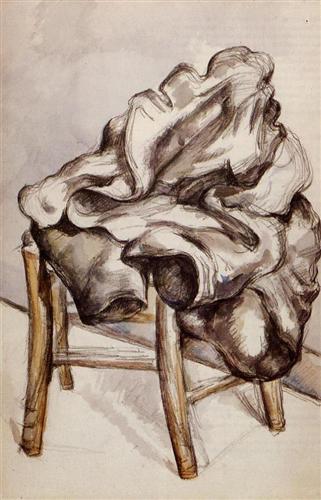 Jacket on a Chair, Paul Cézanne, 1892, wikiart
Jacket on a Chair, Paul Cézanne, 1892, wikiart
2. Atelier Cézanne @ 9 rue Paul Cezanne
Leaving Jas de Bouffan, Emmanuelle drove us to the hilly suburb of La Lauves where Atelier Cézanne is located. Now, his street is called rue Paul Cézanne & I wondered what it was called when he moved in. Again to my sadness, the street sign directing you to “Atelier Cezanne” was tilted, half fallen to the ground in front of a shop “Boutique Paul Cezanne” with closed shutters, showing the disrespect of the locals. A similar feeling of neglect I felt in Jas de Bouffan came back to me. “He is not loved here… people don’t care about him here…” Luckily, it was open. There were some visitors like us who came to see the last work/live place of the legendary artist. How interesting to observe a quiet but empathetic psyche of the small crowd who came in & out of this humble space! Unlike the mob gathered at Monet’s house/garden with heated enthusiasm, the emotions emanating here from the visitors were strangely understated & I enjoyed its sense of privacy.
Skipping reading the prepared sheet that explained the origin of the house etc for the visitors, I walked up the stairway to the second floor. I carefully looked at the shadow the stairway rail cast on the red wall, thinking Cézanne must have seen the same shadow going up and down the stairs every season. Now I was standing inside his atelier, his work space, with “gray’ walls preserved as it was as much as possible. I could not believe that now I was finally inside of my dream. Psychologically & emotionally dramatic, but strangely very calmly, I walked around the not too big studio space with familiar objects I remembered from his work still in tact. I tried to channel myself to the time he lived. Fortunately, everyone here in the studio was quiet, not making too much noise. As I finished circling around a few times, I started to take photos for my memory’s sake. I knew it was childish, but I could not help it. I wanted to carry the physicality of the studio with me home naturally.
Cézanne built this simple house when he sold the family manor where he lived most of his life at the end of his life. He lived & worked here not too long from 1902 – 1906 to be exact. Not as long as Jas de Bouffan where he spent most of his creative life. Compared to the majestic & expensive manor where he grew up & live/worked most of his life, this house is simple with a 2 story wooden structure with a front terrace* (*we just saw a beautiful late watercolor work of this terrace @ the Thaw drawing collection @ the Morgan Library & Museum right after we returned from the trip.) Surrounded by trees & small pathways where he took walks in privacy to the nearby spot where he painted Mt. Saint Victoire, the house stands modestly with an adjunct small shed that now serves as an exhibition space for new artists of our time.
I paid slow but intimate attention to all his private objects: easels, tools, a ladder, a shelf with many familiar objects we see in his paintings, his hats, umbrellas, coats, chairs, a reclining chair, glass bottles & objects, three skulls (“Pyramid of Skulls”), jars (many of “Still Life with a Jar & Fruits”), a plaster angel cast (“Still Life with Plaster Cupid”), a pot belly wood stove, oil lamps (*yes, it was the days of no electricity in this hilly suburb of his), books, letters, flat files & fruits: apples & pears. No actual paintings of his remained there but the computer screen showed a loop of his well-known still life & landscape works instead. The most moving objects I saw were dried up pomegranates (“Still Life with Pomegranates & Pears” which he must have painted in honor of Courbert.) Unlike apples, pears & onions, they become hard & fossilized. I also have pomegranates in my collection of objects. I felt an immediate personal connection to him & I kept it as a shared secret between him & myself. We were told that he painted the gray wall himself. I remembered his passionate insistent idea on the color “gray”.
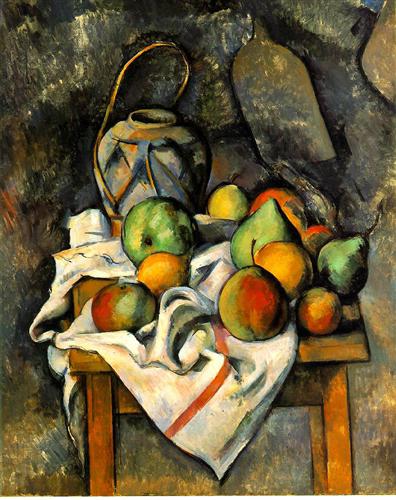 Ginger Jar, Paul Cézanne, 1895, wikiart
Ginger Jar, Paul Cézanne, 1895, wikiart
Then, Steve told me an amazing story. In 1953, the house was saved by 2 people from being bulldozed & demolished to build a new apartment complex on the property. It was a shock to hear such a story as I was walking around in my euphoric state of mind. “Two non-French saved this house & one of them was James Lord!” Steve continued. Local people didn’t care about the house being demolished. James Lord who is known for “A Giacometti Portrait” & John Rewald, a German Cézanne scholar who wrote one of the most comprehensive books on the artist & did a catalogue raisone on his works, got together to raise money to save it from the demolition & succeeded. Then, as it was saved, they donated it to the University of Aix where Cézanne studied law & now it was owned by the university. “He was abandoned by the French people & a German & an American saved this place!?!” I almost shouted out from shock & disdain remembering the dark uncared psyche of the forgotten manor. It was very similar to the psyche we received when we first visited Lowell, Kerouac’s town, in the early 80s. How cruel & strange not to be loved by the locals as these artist gave their lives loving their hometowns! How strange it is to think of their similar obsessions & the attitudes of “rooted-ness” to their hometowns!
In this house, Emile Bernard after breaking off from Gauguin & others of Pont Aven school, stayed as he visited Cézanne. Later, Bernard had become an apostle of “Cézannism” (*the idea & the word he created) betraying his former radical self. He became a twisted classicist, misunderstanding Cézannes’ remarks on classicism. He did not remember that Cézanne did not wish to have a disciple but wished to hand what he discovered to the next generation to keep working on the path to a further quest on art. It gave me a strange physical sensation to think of E. Bernard living in this house with Cézanne. They both walked up & down the stairway where the light made a shadow of the rail on the red wall as I had done. Life is truly strange, continuing itself in such a way, I thought.
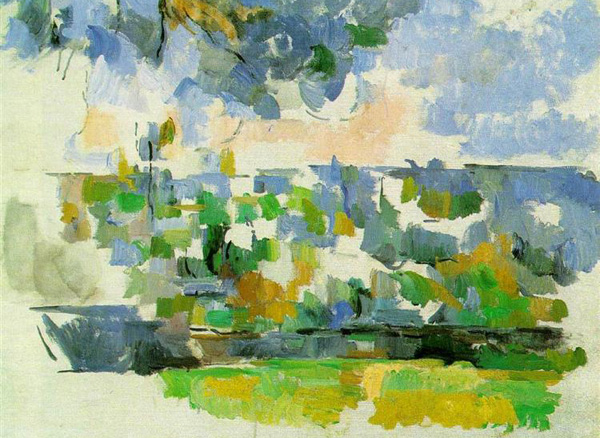 The Garden at Lauves, Paul Cézanne, 1906, wikiart
The Garden at Lauves, Paul Cézanne, 1906, wikiart
3. Mt. Sainte – Victoire
The landscape thinks itself in me. And I am its consciousness. – Cézanne
Leaving Atelier Cézanne, Emmanuelle drove us to see “the” mountain. The sacred mountain: Mt. Saint Victoire. We again went through a magical dry landscape with pines up to the hillside to see the mountain. The immediate impression was the otherworldly monstrosity of geology of the area. Hard rocks & boulders pushing themselves like dense vengeful innards from out of the earth with little earth/dirt as if the inside of the earth was revealing the mystery of the universe itself. The harsh physical materiality of the landscape was so intense & frightening that you almost forgot that what you were facing a landscape. Thick greenery, mostly pines & low bushes were growing out of the hardness of the surface of the cooled down rolling lava of the earth’s fire where there were no water or earth to grow from.
And the air. Ahhhh… it was so clear that it made you forget that you had the inner & outer physical selves constituting your physical body. It was not dry or crisp; it was translucent. No humidity; no dry-ness, but, just the clarity of the air particles. And LIGHT! Ahhhh… I have never experienced this type of immense cosmic light in my life that pierced everything through with no obstacles at all. LIGHT was so cosmic that you did not need to seek its source. You were just in it & became it. The adjective “abundant”, “full” or “sharp” would not be able to describe this LIGHT. Its expansive-ness was endless & benevolent. You were not just enveloped in it but you became part of it, changing the cell molecules of your physical & metaphysical existence.
And the mountain. They hovered quietly, majestically, gracefully & powerfully into the sky. “Ahhh… now I am facing the mountain as Cézanne did…” Strangely, my mind calmed down & I was seeing the mountain as it stood, totally mesmerized but quietly. This mountain was not a mountain in a conventional sense. It was a tremendously dense & huge single piece of rock, rather than a mountain covered with earth/dirt. Images of his paintings came back to my eyes. White; blue; pink; grey… with pine branches & the sky. Shadows & LIGHT. Mt. Saint Victoire. The mountain of St. Victory. What a perfect name it was to be called with! A sacred mountain for a saint painter who dedicated his life to realizing “truth” in his art.
What I saw was not a mountain in the landscape, but the concrete evidence of the cosmic physicality of the universe. What is it? What makes this massive materiality existent? What is Cosmos? What is Universe? What is Man? What am I? The intensity of its physicality made me wonder about one of the unsolvable philosophical questions regarding the origin of “existence”. It was this immense concrete physicality that pulled Cézanne to come back to this mountain again & again. It was not a question of thoughts. It was the question of our physical existence, not just human, but everything, trees, the sky, clouds, the rocks, light/shadow, stars, a moon & the sun… all the cosmic elements that consist of everything I am & everything I face & everything I think & feel.
For Cézanne, it was not a landscape. It was a cosmic quest. It was a spiritual journey. It was a dialogue with “God” if I use such a word for anything primordially mysterious & fundamentally unknowable. I remembered a small white cross & a rosary hanging in his studio wall & the fact that he became a devoted Catholic at the end of his life. Whether you believe in God or not was not a problem here. He was completely immersed in his own way of doing a spiritual search as an artist. It was not about the concept; it was about the actuality of the reality. That was why he preferred to use the word “realization” to describe his art. Yes, he was a true to the bone “realist”. A devotional realist who went to the limits of reality & beyond by “seeing.” His life was consumed by learning “how to see” & “how to realize what he sees through his métier on the materials/canvases.” How difficult it is to see clearly! 正見 (truthful seeing/right seeing) is also one of important Buddhist teachings. You see directly & truthfully without any illusions, delusions or diversions. That was what Cézanne was involved with his endless efforts. Seeing.
It was completely necessary for me to be in the air he breathed & to be in the light he was in & to stand on the surface of the earth he stood to face the reality: “the landscape.” Physically being there, I managed to solve unsolved questions regarding Cézanne & his art. All the questions I’d being carrying all these years had started to fall off from my consciousness as if they were being absorbed into immense LIGHT particle by particle. I felt open & light. Now finally I understood him & his art. Without thinking. Thinking without words. I saw what he did. I was in peace. For Cézanne, this immense out-worldly monstrous geology of the area was the gateway to go through to paradise. He saw it. He found the truth hiding behind our fixed sense of reality. It was not a secret any more. It was the cosmic truth of
色即是空空即是色
(color is void; void is color)
It is a “sacred” mountain & it stands gracefully but with an almost authoritarian majesty that looks very forbidden. But actually, it is not fobidden to anyone. Emanuelle said she & Aida enjoyed hiking on it recently. I said to her in a surprise, “Can you really walk on it?” & she said, “Yes! It is beautiful there!”
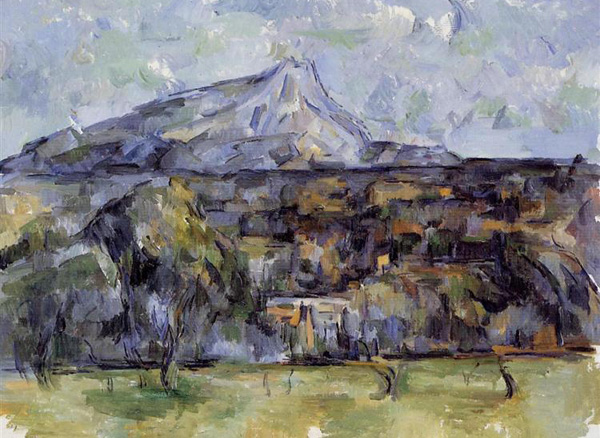 Mont Sainte-Victoire Seen from les Lauves, Paul Cézanne, 1906, wikiart
Mont Sainte-Victoire Seen from les Lauves, Paul Cézanne, 1906, wikiart
